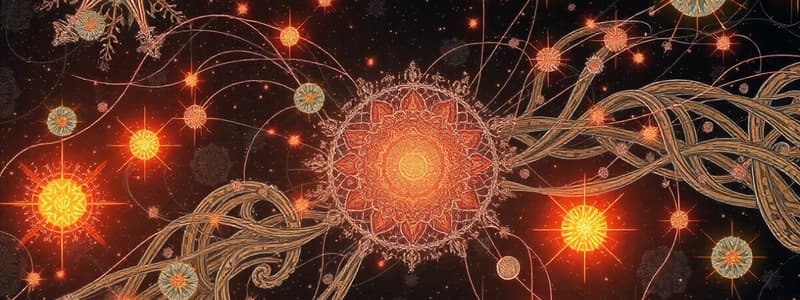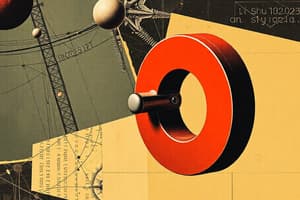Podcast
Questions and Answers
Which of the following best describes why a rolling ball eventually stops on the ground?
Which of the following best describes why a rolling ball eventually stops on the ground?
- The force of gravity acting on the ball overcomes its momentum.
- The ball's initial energy dissipates into the surrounding air.
- The ball's internal structure experiences fatigue, leading to its stop.
- Friction between the ball and the ground converts kinetic energy into heat and sound. (correct)
If there was no friction between our feet and the ground, what would be the most likely result when trying to walk?
If there was no friction between our feet and the ground, what would be the most likely result when trying to walk?
- We would experience uncontrolled slipping, making it difficult to maintain our balance or move forward. (correct)
- We would be able to glide effortlessly over the ground with complete control.
- Our feet would experience increased traction, allowing us to walk faster.
- Our feet would exert increased energy to generate required traction to walk.
Which of the following scenarios demonstrates a force causing a change in the object's shape or size?
Which of the following scenarios demonstrates a force causing a change in the object's shape or size?
- A ball rolling across a field stops after a while .
- Kneading flour to make dough. (correct)
- A refrigerator door remaining shut due to the magnet.
- The kicking of a soccer ball.
How do electromagnets differ from regular magnets?
How do electromagnets differ from regular magnets?
Which of these provides an example of magnets being used to aid in storing or managing information?
Which of these provides an example of magnets being used to aid in storing or managing information?
Which of the following best describes the historical origin of the term 'magnet'?
Which of the following best describes the historical origin of the term 'magnet'?
While a bar magnet and a horseshoe magnet have different shapes, what characteristic do they both share in terms of magnetic strength?
While a bar magnet and a horseshoe magnet have different shapes, what characteristic do they both share in terms of magnetic strength?
If two magnets are positioned such that their south poles are facing each other, what will be the effect?
If two magnets are positioned such that their south poles are facing each other, what will be the effect?
Which of the following materials does not exhibit magnetic properties?
Which of the following materials does not exhibit magnetic properties?
Considering magnetism as a force, how does it behave when the interacting objects are no longer in contact?
Considering magnetism as a force, how does it behave when the interacting objects are no longer in contact?
Which of the following is a type of force that slows down or stops movement?
Which of the following is a type of force that slows down or stops movement?
If a ring magnet and a bar magnet are brought together, what could be a possible interaction?
If a ring magnet and a bar magnet are brought together, what could be a possible interaction?
What key concept defines magnets' ability to pull certain materials towards themselves?
What key concept defines magnets' ability to pull certain materials towards themselves?
Flashcards
Force and Motion: Starting Motion
Force and Motion: Starting Motion
Force can cause objects to start moving if they are at rest.
Force and Motion: Changing Motion
Force and Motion: Changing Motion
Force can change the speed and direction of a moving object.
Friction
Friction
Friction is a force that opposes motion between surfaces in contact.
Magnets
Magnets
Signup and view all the flashcards
Electromagnets
Electromagnets
Signup and view all the flashcards
What is a magnet?
What is a magnet?
Signup and view all the flashcards
What are magnetic materials?
What are magnetic materials?
Signup and view all the flashcards
What are non-magnetic materials?
What are non-magnetic materials?
Signup and view all the flashcards
What are the poles of a magnet?
What are the poles of a magnet?
Signup and view all the flashcards
How do magnet poles interact?
How do magnet poles interact?
Signup and view all the flashcards
What is a force?
What is a force?
Signup and view all the flashcards
What is friction?
What is friction?
Signup and view all the flashcards
What is a horseshoe magnet?
What is a horseshoe magnet?
Signup and view all the flashcards
Study Notes
Magnets: Properties and Uses
- Magnets are special stones or man-made objects (iron or steel) that interact with certain metals.
- Natural magnets, like magnetite, attract iron.
- Man-made magnets come in various shapes (U-shaped, horseshoe, bar, rod, ring, button), depending on their application.
Magnetic Materials and Interactions
- Magnets attract certain materials (magnetic materials): iron, nickel, cobalt, and steel.
- Examples of magnetic materials include nails, paper clips, and steel locks.
- Non-magnetic materials are not attracted by magnets, such as gold, silver, aluminium, copper, wood, paper, plastic, glass, and clay.
- Magnets have two poles: north (N) and south (S). The strongest magnetic force is at the poles.
Magnetic Poles and Interactions
- Like poles (N-N or S-S) repel each other.
- Unlike poles (N-S) attract each other.
- Attraction between unlike poles is stronger than repulsion between like poles.
Force and its Effects
- Force is a push or pull that can change an object's motion, speed, direction, shape, or cause a moving object to stop.
- Examples: pushing a car, pulling a trolley, squeezing a lemon, kicking a ball.
- Friction is a force that slows or stops a moving object.
Uses of Magnets
- Magnets are found in many everyday devices, including telephones, headphones, speakers, and some appliances.
- Small electromagnets are used in computers and video recorders for data handling purposes.
- Refrigerator doors often have magnets to keep them closed due to the steel in the refrigerator itself.
Electromagnets
- Electromagnets are temporary magnets that only act as magnets when electricity flows through them.
Studying That Suits You
Use AI to generate personalized quizzes and flashcards to suit your learning preferences.




